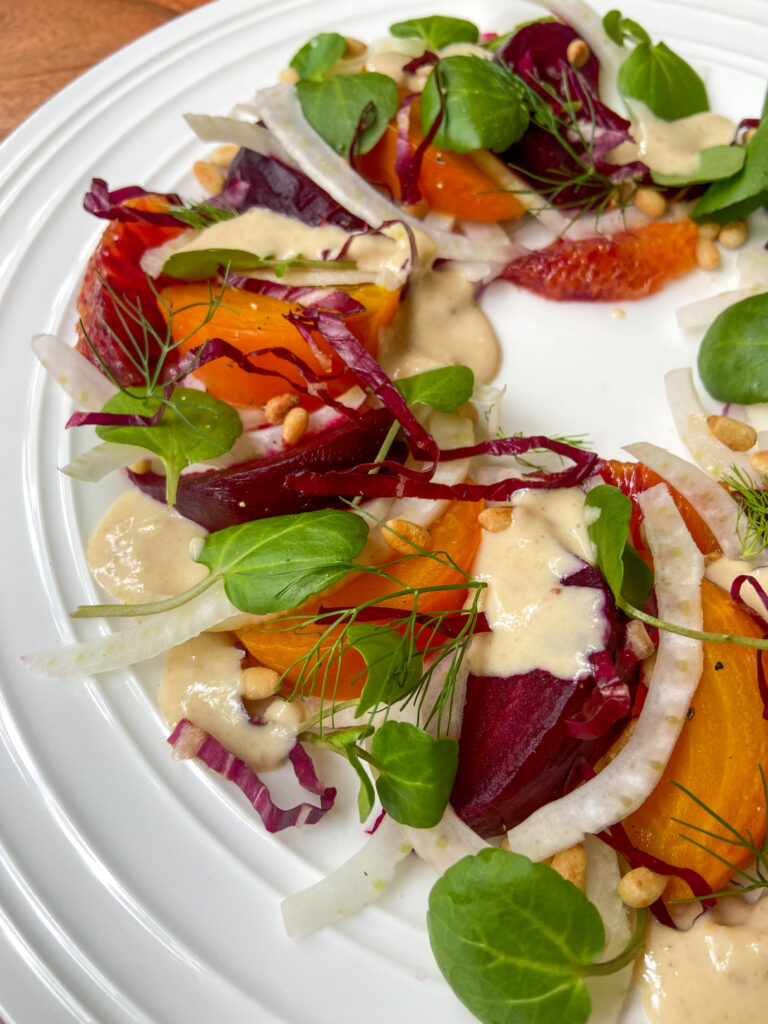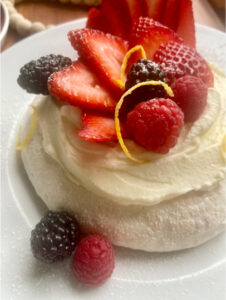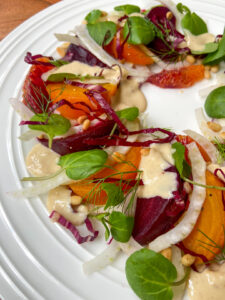Introduction
Beetroots, commonly known as beets, have beautiful, earthy flavor and aromas. The contrasting shades of red and golden beets really pop up on this dish. No matter the color, beets are loaded with vitamins and minerals, especially folate and manganese, as well as dietary fiber. Talk about healthy superstars! Fennel ribbons add a crunchy texture and a bright licorice flavor to this salad. The sweetness of the blood orange supremes plays off with the creaminess of the dressing and the pleasant, mild bitter flavor of the radicchio and watercress.
Ingredients
- Beets—red and gold
- Fennel bulb
- Baby watercress
- Blood orange (or orange for substitution)
- Red onions
- Radicchio
- Raw pine nuts
- Tahini
- Freshly squeezed lemon juice
- Dijon mustard
- Honey or maple syrup
- Extra virgin olive oil
- Coarse sea salt
- Freshly ground black pepper
Highlights
- Beets are nutritional gems but so are their greens. As with other roots, many markets remove their tops before displaying them to sell; but just in case you’re able to find them whole, I suggest you cherish the beautiful, dark greens for they are loaded with healthful nutrients. In fact, beet greens are considered one of the best 50 foods for healthier people and healthier planet (WWF’s Future 50 Foods).
- Fennel bulb is rich in minerals such as potassium, manganese, and phosphorus. A medium-sized bulb has nearly half of the RDA of Vitamin C and a good amount of vitamin B9 or folic acid. I love using the bulb, raw and crunchy or cooked and tender, as well as the stems and fronds.
- Blood orange may be substituted by other varieties of orange such as navel or cara cara but also tangelo or mandarin. Blood orange has a striking color that goes so well with the beets in this salad. Use the peel to make tea and flavor water as well as the rind to add to salads or baking dishes that call for lemon zest.
- Pine nuts can be expensive and, sometimes, hard to find. I consider them absolutely delicious and worth the ‘splurge’; however, it’s perfectly ok to swap them for crushed walnuts or pecans and even sunflower seeds in this recipe. I like to buy them raw and toast a little at time for special recipes such as this. Pine nuts are small but pack a great deal of nutrition including omega-3 fatty acids, iron, and even protein.
- Tahini, a paste made from toasted and ground sesame seeds, is used as a condiment in many Middle-Eastern and African dishes that I grew up loving. It provides a velvety texture to the dressing in this salad and pairs up so well with the acidity of the lemon juice. Tahini is nourishing and rich in minerals such as copper and selenium. It is one of my favorite ingredients to make dips and dressings!
- Honey is a great source of probiotics. Science-based studies suggest that it can stimulate the growth of beneficial gut bacteria while reducing the presence of infectious bacteria such as E. coli and Salmonella. To make this recipe fully plant-based or vegan, honey can be replaced by maple syrup.
- The density of this dish—both in fiber-rich ingredients as well as nutritional content—make it a perfect entrée, not just a salad or first course. It illustrates how plant-based ingredients such as vegetables, fruits, nuts, and seeds really have the potential to provide all the essential nutrients humans need for their wellbeing and to be the protagonist of any table, at the center of the plate.



